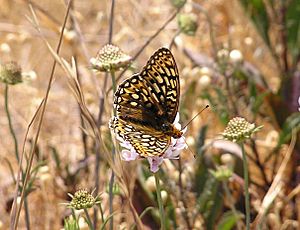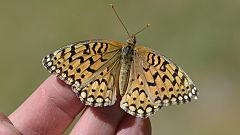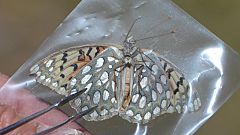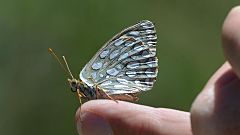Callippe fritillary facts for kids
Quick facts for kids Callippe fritillary |
|
|---|---|
 |
|
| S. c. callippe | |
| Scientific classification | |
| Synonyms | |
|
The Callippe fritillary (scientific name: Speyeria callippe) is a beautiful butterfly found in North America. It belongs to a group of butterflies called "brush-footed butterflies" (Nymphalidae). These butterflies are known for their bright colors and interesting patterns.
Contents
What is a Subspecies?
Sometimes, animals of the same species can look a little different depending on where they live. These slightly different groups are called subspecies. The Callippe fritillary has many different subspecies. Each one might have small differences in its looks or where it lives.
Where Do They Live?
Callippe fritillary butterflies live across a wide area in North America. You can find them from British Columbia in Canada, all the way east to South Dakota and Manitoba. They also live south into California, Nevada, Utah, and Colorado.
These butterflies like to live in certain kinds of places. They often prefer areas with sagebrush, dry forests, or the edges of forests. You might also spot them in chaparral (a type of shrubland) and on grassy hillsides.
What Do They Look Like?
The Callippe fritillary is a medium to large butterfly. Its wings can spread out about 5 to 6.4 centimeters wide. The top side of their wings can be a tawny (light brown) color or a bright reddish-brown. They have cool black zigzag stripes spread evenly across their wings. The very edge of their wings is black-brown, with a line of pale, crescent-shaped spots.
If you look at the underside of their front wings, they are a reddish-fawn color. They have similar patterns to the top side, plus a row of shiny silver crescent spots along the edge. The underside of their back wings is brown. These wings have about 22 large, shiny silver spots. They also have triangular silver spots near the edge, outlined with thin brown lines.
When they are caterpillars, they are grayish. They have patches of black and gray, and cool black-orange spines on their bodies.
Life Cycle of the Butterfly
Callippe fritillary butterflies usually have one generation each year. This means they complete their entire life cycle (egg, caterpillar, pupa, adult) once a year.
Adult butterflies fly from May to August. The males often fly around looking for females. Females usually appear a little earlier than the males. After mating, the female butterflies lay their eggs. They often lay them in leaf litter near the plants their caterpillars like to eat.
The tiny caterpillars hatch from the eggs. These young caterpillars spend the winter without eating. When spring arrives, they wake up and start to munch on the leaves of certain plants. Their favorite foods include different types of violets, such as Viola pedunculata, Viola nuttallii, Viola beckwithii, Viola douglasii, and Viola purpurea.
Gallery




